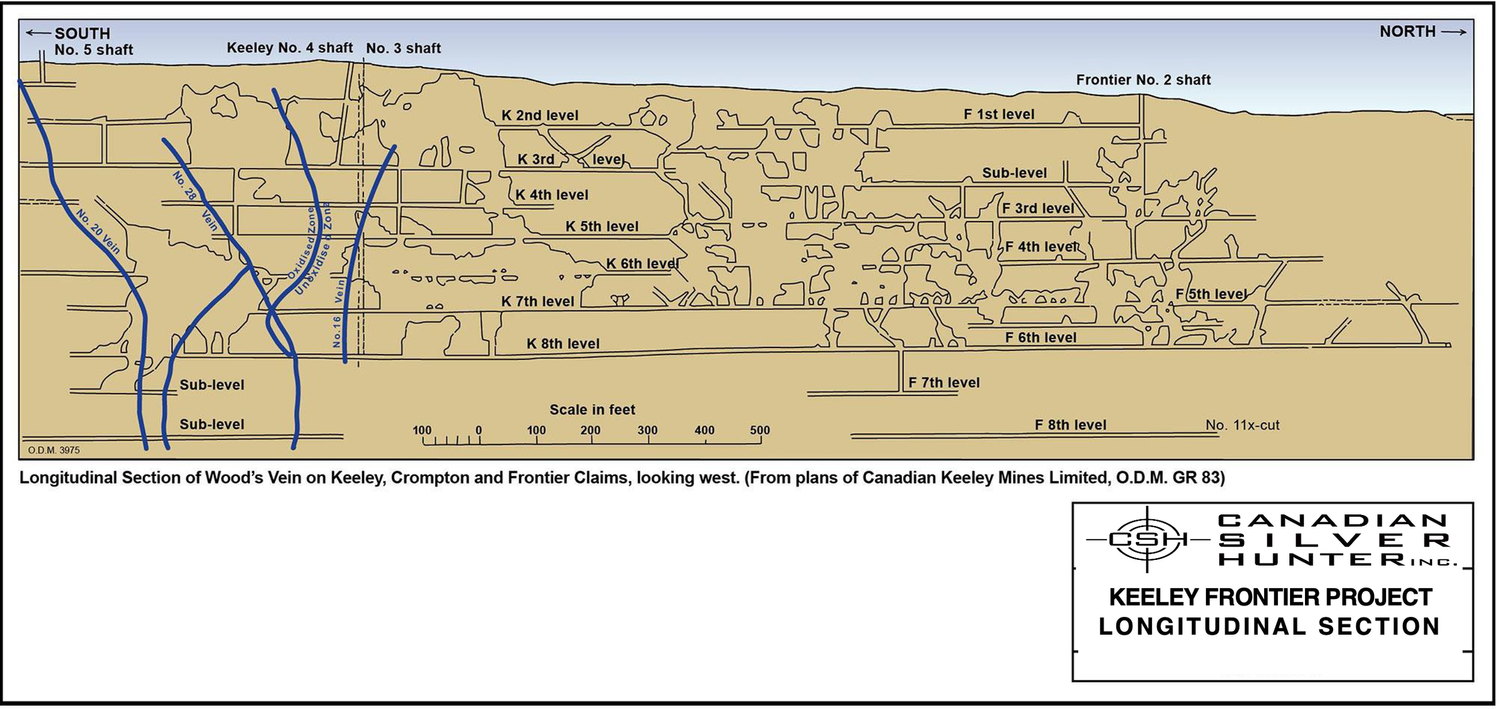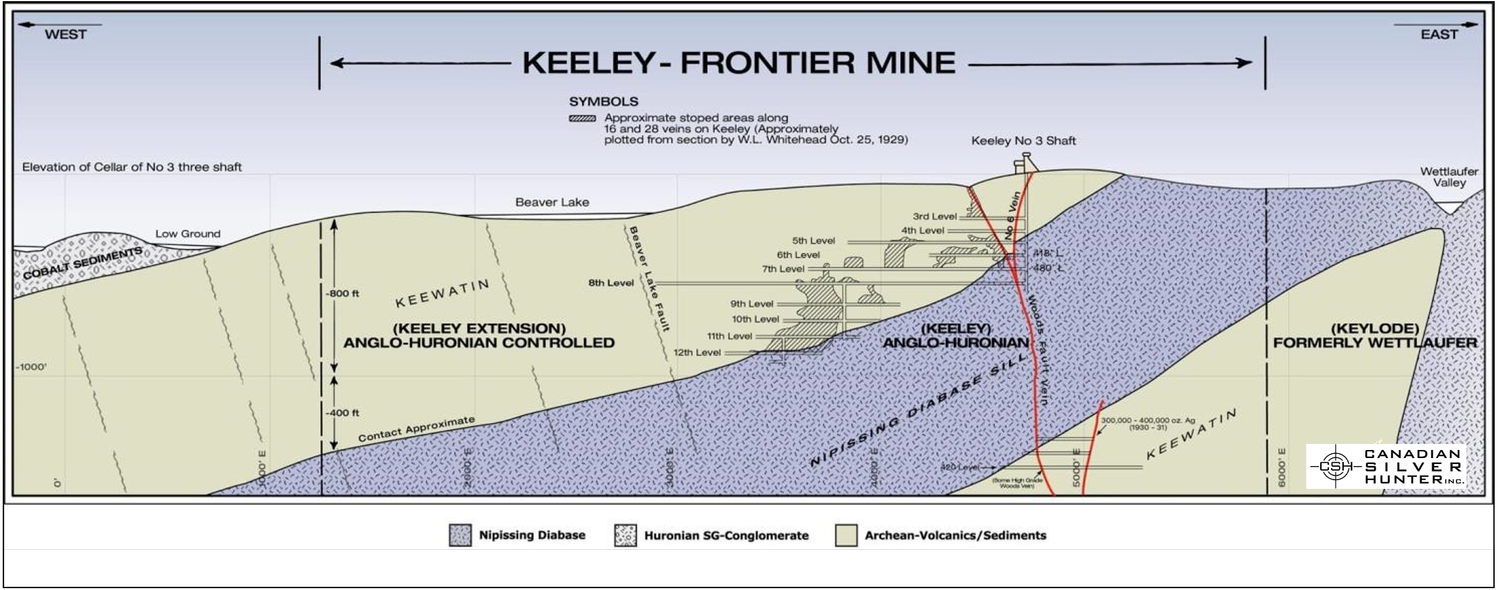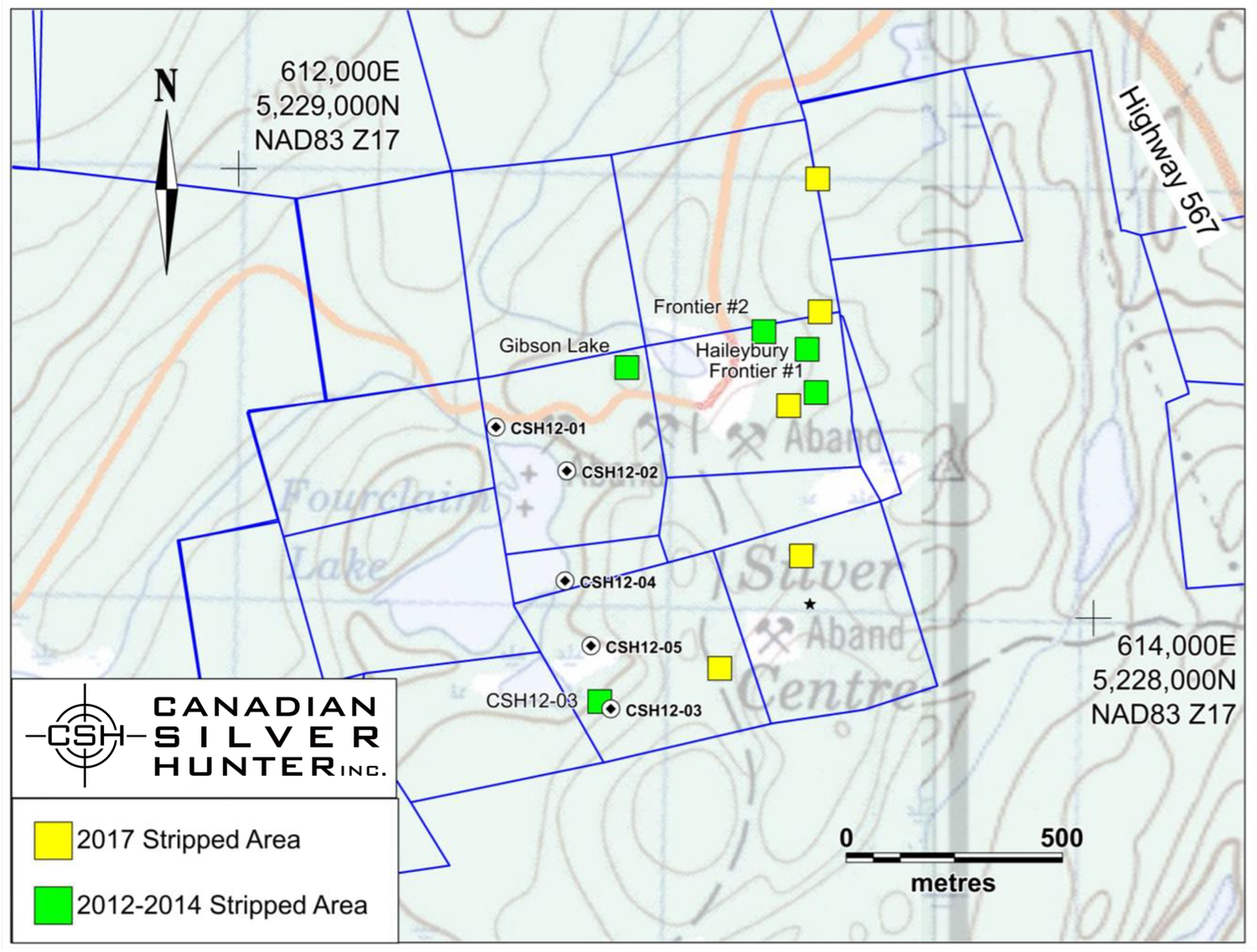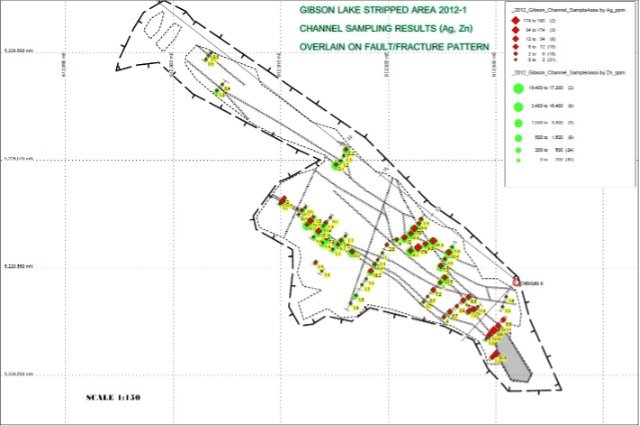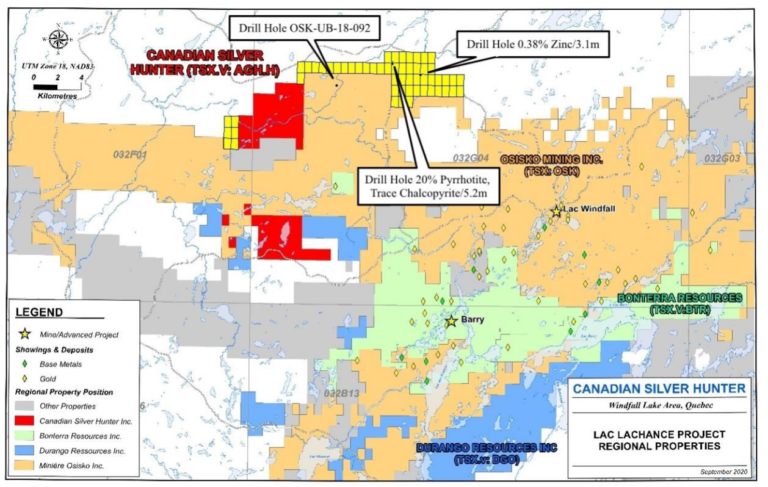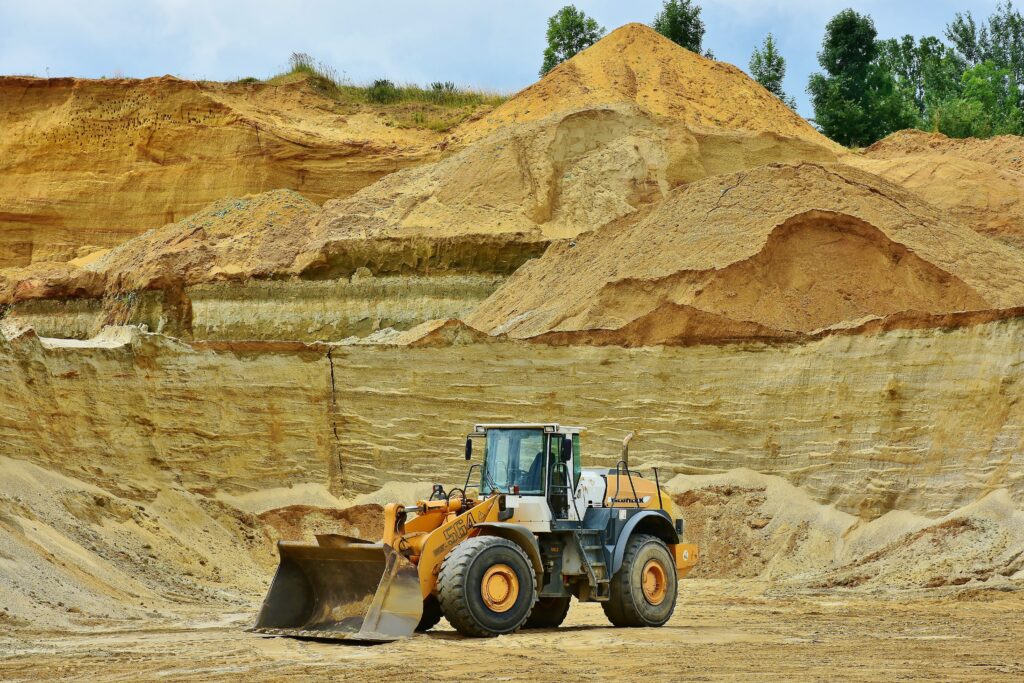
ABOUT US
WE PRODUCE
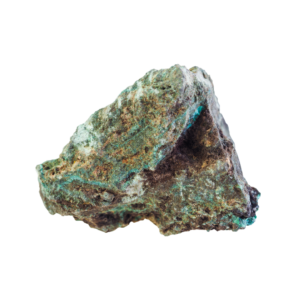
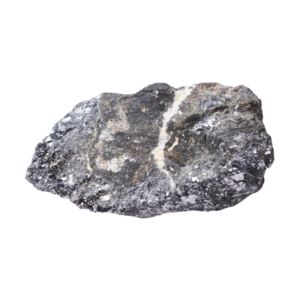
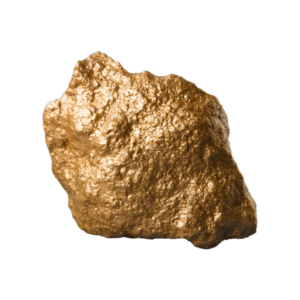
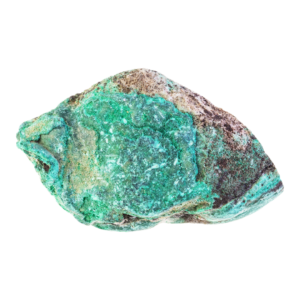
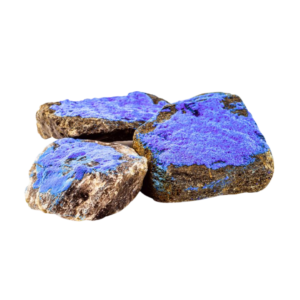
OUR TEAM
Jeffrey Hunter – President, Chief Executive Officer, Director
Mr. Hunter is the Co-Founder, President and Chief Executive Officer of the Corporation since being appointed in November 2006. Jeff has over 25 years of direct experience and exposure in the junior exploration and mining industry, working as an investment banker and corporate financer for many public and private mineral resource exploration companies. Mr. Hunter was previously a co-founder, director and VP Corporate Finance of Grey Island Systems International Inc. (now part of BSM Technologies.), a Canadian company engaged in the development of proprietary GPS related tracking software.
Robert Gordon MBA, P.Eng – Director
Mr. Gordon has over 30 years of technical experience in the exploration industry as well as 20 years of management experience in the sector. Mr. Gordon graduated from Queens University with a B.Sc. in Geological Engineering (Geophysics) and from the University of Western Ontario with an M.B.A. and became a director of the Company (CSH) in April 2011. Rob is currently Marketing Manager with Quantec Geoscience, a company that provides geophysical exploration and data analysis services. Mr. Gordon was an appointed non-member councilor of the Association of Professional Geoscientists of Ontario (APGO) from 2009 to 2016.
Tim Towers – Director
Mr. Towers, BA Economics, Hon Bcomm Finance, has spent the past 30 years in the mining industry in various roles as a director, CEO, President, CFO, Corporate Secretary and Co-founder of Silver Shield Resources (now Bluesky Digital). Tim is the former CEO of Conquest Resources and Northern Nickel Mining, as well as serving as the Corporate Secretary for Temex Resources, and YGC Resources.
Wayne Holmstead P.Geo – Exploration Manager
Wayne Holmstead (P.Geo) graduated with a B.Sc. from the University of Toronto. Wayne has over 40 years experience in Canadian mineral exploration and project administration. He has managed numerous junior exploration companies, holding the titles of Exploration Manager, President, Vice President Exploration and Director.
Wayne is skilled in traditional exploration methods in geology, geophysics and geochemistry as well as newer computer based techniques and database research. His exploration work has led to the identification of significant exploration targets, and the discovery of several mineral deposits including gold, molybdenum, base metals, and Platinum Group Elements, with an emphasis on Ontario and Quebec.
Wayne is a specialist in Gold and Base Metal exploration but also has extensive experience in the exploration for Uranium, Rare Earth Metals, Lithium and other ‘green energy’ metals.
PROJECTS
Keeley & Frontier Mines
Canadian Silver Hunter’s wholly owned Keeley and Frontier Mines are located in Silver Centre, just south of Cobalt, Ontario. The Keeley-Frontier Mine produced a total of 19.2 million ounces of silver and over 3.3 million pounds of cobalt at a recovered grade of 58 ounces of silver per ton, and 0.5% cobalt (3.3 pounds/ton) respectively.
Historically the South Lorrain Township (Silver Centre) had produced a total of 23,338,906 oz of silver with 82% of this coming from the Keeley and Frontier Mines, and over 50% from the Keeley Mine itself
The Keeley-Frontier mine also had the best cobalt-to-silver ratio of all the major historic mines in the Cobalt camp, suggesting that there may be other silver-cobalt-rich areas that were not targeted or exploited during mining.
The Keeley Frontier mine has extensive underground workings, including ten shafts and several winzes extending to a depth from a surface of 1525 feet (465 meters).
It is also of interest to note that historic exploration and production in the South Lorrain silver camp focused on underground drifting along narrow high-grade structures and there was generally no exploration for wider, lower-grade mineralized zones using geophysics, surface drilling, or power-stripping. Strong chargeability anomalies from earlier IP surveying completed by the Company suggest the presence of disseminated sulphide/arsenide targets along a northwest-trending anomaly 100 meters wide by at least 400 meters long stretching northwest from the Gibson Lake area stripping.
The Company intends to gain a greater appreciation for the silver and cobalt zonation within the mine and close to the surface as well as new prospective mineralization and the potential for disseminated mineralization, which could be amenable for bulk mining and potential open pit development.
Selected results;
· Diamond drill hole CSH12-03 returned significant silver values between 111.0 and 122.3 meters downhole, including the following screen metallic assays:
1517.0g/tonne over 0.3 meters
479g/tonne over 0.4 meters
91g/tonne over 0.3 meters
The entire interval starting at 111.0 metres returned a composite silver value of 72.47 g/t Ag over 11.3 meters, including 168.22 g/t over 4.2 meters. This zone appears to be related to a new silver-bearing structure as well, anomalous silver, cobalt, and copper values occur throughout the upper portion of CSH12-03 associated with faulting, lamprophyre dykes, and syenite bodies.
· CSH12-05 returned a composite silver value from the Beaver Lake Fault of 398.42 g/tonne over 1.9 meters.
A total length weighted composite for all 77 channel samples taken is 11.33 g/t Ag, 0.12% Pb, 0.14% Zn, and 0.12% Cu. Silver values ranged from 0.4 g/t to 190 g/t, with only seven samples assaying below 1.0 g/t Ag. A similar widespread dispersion of Pb, Zn, and Cu values was also noted, with a high correlation to Ag values.
Sampling along the edge of Little Beaver Lake, located just south of the Keeley mine main shaft was completed in one location to examine the depth of tailings and distribution of silver and other metals in the tailings profile. Five (5) grab samples of tailings material (sand, silt, and clay) exposed at various depths in one location by an excavator at depths ranging from surface to 1.8 meters depth returned silver values of 404 g/t Ag, 191 g/t Ag, 175 g/t Ag, 124 g/tonne and 74.8 g/t Ag. The tailings grab samples also assayed up to 0.053% bismuth, 0.33% cobalt, and 0.09% nickel. (PR January 18, 2013).
The Company has commenced assimilating all recent and historic production, drilling, and development data on its Silver Centre property, with plans seeking to maximize the mineral potential of the property. Follow-up drilling is planned, and additional areas for surface sampling and multi-element assaying are being evaluated by ongoing geological mapping. Follow-up work being considered on the Gibson Lake and Keeley South targets include additional power stripping, channel sampling, and geophysics followed by a shallow, tightly spaced drill program, based on existing and new data. This work will also aid in correlating numerous collapsed trenches on the surface with silver-copper-cobalt-bismuth-nickel bearing structures outlined by more recent drilling.
LAC LACHANCE, WINDFALL LAKE
Canadian Silver Hunters wholly owned Lac Lachance property is located in the Windfall Lake area of Quebec, near the town of Lebel sur Quevillon. The Company controls a total of 177 mining claims covering just over 9,900 hectares.
The Lac Lachance north and south block properties occur within the Urban-Barry greenstone belt located in the Northern Volcanic Zone of the Abitibi geological sub-province. The northern portion of the Lac Lachance claims cover electromagnetic anomalies associated with east-west trending fault zones on the northern limit of the Urban-Barry volcanic belt that hosts numerous gold deposits, including the Osisko Mining Inc., Windfall Lake Gold Deposit.
The nearby Windfall deposit is classified as a pre-Temiskaming intrusion-associated gold deposit due to: 1) a temporal and spatial association of gold with felsic calc-alkaline QFP (quartz-feldspar porphyry) intrusions; and 2) the main gold event (i.e., vein- and replacement-type mineralization) being interpreted to pre-date known regional scale deformation. Gold mineralization is structurally controlled and is hosted in: 1) a series of extensional faults and fractures that are concentrated in areas of contrasting competencies, often located proximal to the contacts between pre-mineral QFPs and host volcanic rocks; 2) along boundaries between flat-lying lithologies and steeper structures; and 3) along boundaries of chemical contrast between ultramafic-mafic and felsic rock types.
The mineralization style is variable (i.e., vein- to replacement-type) and is largely dependent on host rock composition. Mineralization consists of a network of quartz-pyrite veins and an associated silica-sericite-pyrite alteration assemblage. The QFP intrusions were emplaced as a product of tectonism and act as competent host rocks that localize favourable structures for gold- bearing hydrothermal fluids.
Recent work by Osisko in the vicinity of the Lac Lachance north claim group has indicated gold mineralization detected by diamond drilling associated with conductive sulphide zones. A 2018 Osisko report stated that drill hole OSK-UB-18-092, located within 900m of Canadian Silver Hunters claims, “intersected 0.71 g/t Au over 1 metre. This grade is hosted in a massive sulphide zone within a strongly silicified unit of intermediate composition. Other anomalous gold values were intersected, ranging from 0.11 to 0.48 g/t Au, associated to other massive pyrrhotite-pyrite zones, often located at their contacts”. (GM70939, Quebec Assessment Files).
The geological conditions that hosted gold mineralization on Osisko Mining’s Windfall Lake property also exist on Canadian Silver Hunter’s northern claims.
LOST DOG
The Lost Dog property consists of 52 contiguous mining claims covering close to 1,300 hectares. The property is located in Denton Township, approximately thirty kilometres south-west of the Timmins city center, and 12 kilometres west of Pan American Silver’s West Timmins Mine, in the Porcupine Mining Division of Northern Ontario.
Results from the November 2020 soil sample program identified five clusters of anomalous values on the property. Anomalous values in gold, silver, copper, lead and zinc provided excellent targets for follow up work. Of the 350 samples collected and submitted for analysis, just over one third assayed at or above the minimum detection limit for gold (0.005 ppm). The samples also returned a single sample assay result of 13g/t (ppm) silver, and another sample that returned 416 ppm copper (CSH PR, February 09, 2021).
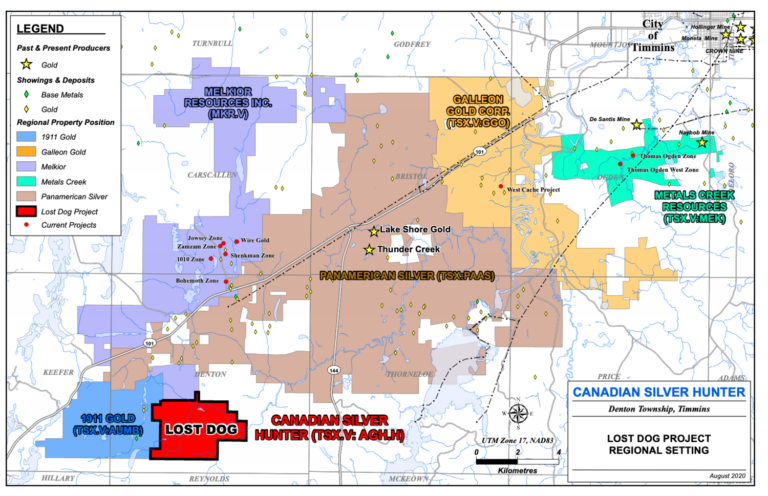
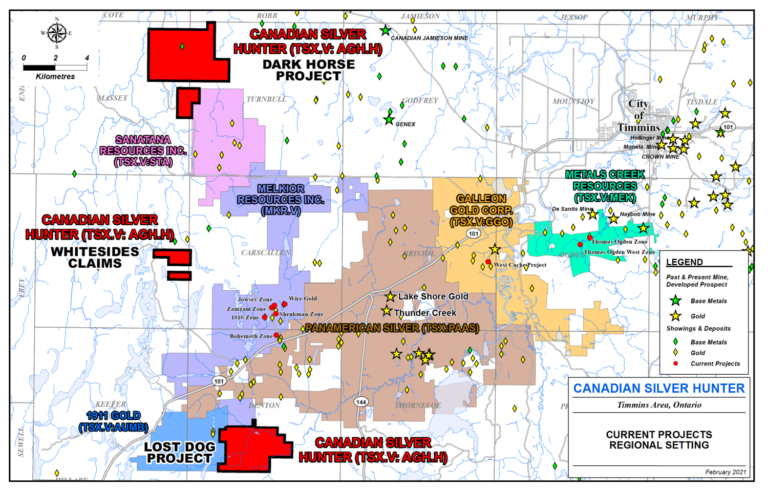
DARK HORSE
The Dark Horse Property consists of 80 mining claims, in two blocks, totaling 1,762 hectares, located in Turnbull and Massey Townships, West Timmins, Ontario. The property is located approximately 27 km northwest of the prolific Timmins gold mining camp and immediately north of the Sanatana Resources Gold Rush Property (see Sanatana Press Release dated Jan 13, 2021).
Recent work by Sanatana on the Gold Rush property located immediately south of the Dark Horse property included surface sampling programs that identified numerous gold-bearing and gold/silver-bearing quartz vein systems on their property. The best gold result was from a grab sample of 59.2 g/t gold from a brittle ductile shear in the vicinity of the north-south trending DeSantis Fault, which has been documented to cross the Company’s Dark Horse Property for approximately 3.4 km.
Sanatana Resources has also uncovered two gold-bearing zones at the North Shaft Prospect (see Sanatana Press Release March 15, 2021). The Eastern zone is a new discovery that trends at 125° (ESE) for over 100m with assays from trace to 6.35 g/t Au over 0.75 m. The Western Zone trends 260° (West) for 70 m and includes a 27.3 g/t grab sample and a channel sample of 1.94 g/t Au over 1 m. These new discoveries by Sanatana are located about three kilometres south of the Dark Horse Property.
MEDIA
Inc co-founder, president and CEO Jeff Hunter joined Proactive’s Stephen Gunnion with details of the company 2022 exploration programs at the Lac LaChance property in the Windfall Lake area of Quebec and the Keeley Frontier mine, south of Cobalt in Ontario. Hunter telling Proactive that the company expects a rerating in its share price as it progresses its cobalt and silver projects and the prices of the metals continue to improve, supported by demand for electric vehicles.
German Mining Networks GmbH caught up with Jeff Hunter, CEO of Canadian Silver Hunter and gave us an update on CSH’s recently completed soil sample program at their Lost Dog property (previously discussed in our 2020 interview) and details about their recent acquisition.
The Lost Dog’s initial results are highly encouraging, with more likely to come as the property is still largely unexplored. CSH is a sleeping giant in the gold and silver space and provides investors with huge potential for discovery.
German Mining Networks GmbH
Hauptstrasse 82, 98593 Floh-Seligenthal, Germany
pp@german-mining.com
Special Emphasis On:
* Min 00:20: Update on the Lost Dog property
* Min 02:43: Lost Dog Spring Program
* Min 03:52: Dark Horse Acquisition
PRESS RELEASES
WHY YOU SHOULD INVEST
1
REASON
TEXT
2
REASON
TEXT
3
REASON
TEXT


